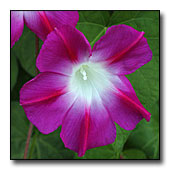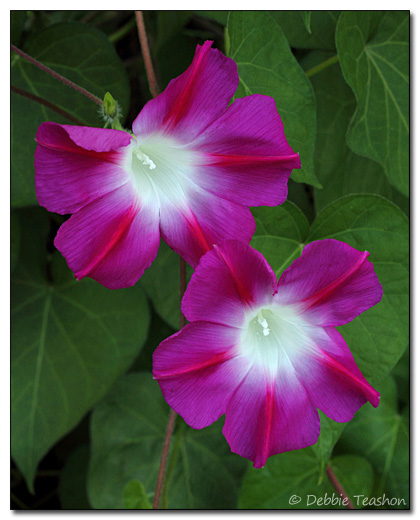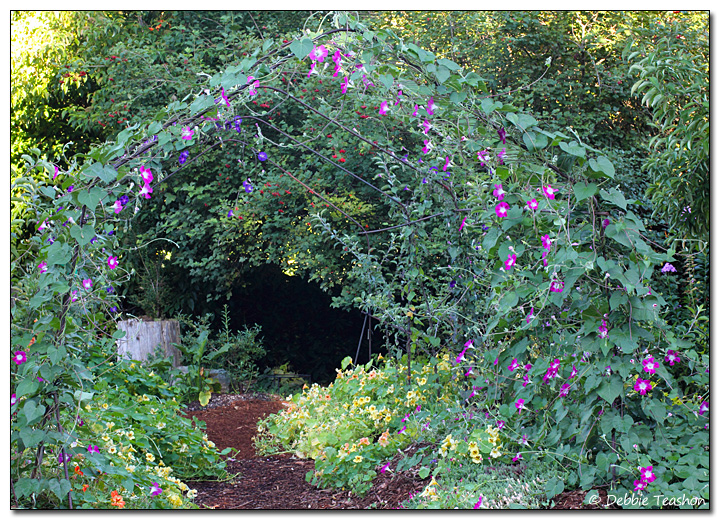Ipomoea purpurea 'Split Personality
TALL MORNING GLORY
syn. Convolvulus purpureus, Pharbitis purpurea
Family: Convolvulaceae
Pronounced: ip-oh-MEE-a pur-PUR-ee-uh

Quick Jumps
Growing Guide
Rainy Side Notes
GROWING GUIDE
.imageright { margin: 10px; float: right; }
Origin:
Garden.
Plant group:
Annual vines.
Hardiness:
Sunset zones: All.
USDA zones: All.
Heat zones: 12-1.
Mature size:
Height: 10-12 feet (3-3.5 m)
Flowering period:
Summer until frost.
Flowering attributes:
Funnel shaped flowers of deep pink-red with a red line down the center of each petal and a white throat. The name comes from the flowers habit of petals curling one way or the other.
Leaf attributes:
Large, heart-shaped leaves.
Growth habit:
Twining climber.
Light:
Full sun.
Soil:
Fertile, moist, well-drained soil.
Propagation Methods:
Sow seed in situ in spring after all danger of frost is over and soil has warmed up.
I successfully start morning glory plants early in the greenhouse. In late April, I soak the seeds in warm water for 24 hours, then plant the seed in the starting medium and place the seed flat on the heat mat in the greenhouse. After seeds germinate, tiny seedlings are transplanted into deep pots with a soil-based potting medium. They grow in the greenhouse on cold days and are brought outside on warmer days until late May. The plants are brought outside to harden off. Around early June, when the soil has warmed, they are carefully transplanted outdoors with as little disturbance to the roots as possible. A handful of complete organic fertilizer is mixed into each planting hole at the time of planting.
If you don't have a greenhouse, start your seeds indoors about 2 weeks before the last frost. Place them in a bright window, but take them outside for the day during warm spells. Gradually acclimate seedlings to outdoor living and transplant seedlings in the ground when soil temperatures warm up.
Pests and Diseases:
Slugs, snails, spider mites, white blister, rust, fungal leaf spots, stem rot, and thread blight may be a problem.
Rainy Side Notes

Although I've seen some people describe the curling blossoms as star-shaped, I think that is a bit of a stretch. However, it does make for an interesting flower, as you don't know which way the petals are going to curve—behind or forward, with some petals not curling at all. The habit makes the flowers look wind-blown and adds some character.
I start my seeds ahead of time and like to grow them in tall d2 pots to give the root system a good start. This year I ran out of the taller pots as I don't normally grow two different kinds of morning glories, so this one went into a standard 4- inch pot. It took the annual vine more time to get growing in the garden once planted. It sat there and sulked for a while. Once it settled in, it exploded in growth and surpassed the Ipomoea 'Star of Yelta' in growth and vigor. The cause of I. ‘Split Personality’ getting a slower start in the garden may not necessarily be because of the shorter pots. There may be other reasons, such as the plant possibly might need more warmth to get growing in comparisons to others in the genus; nonetheless, I thought I should mention it in my notes.
This rampant grower loved the apple tree's rebar scaffolding in the new edible garden, climbed it with ease, and swamped the newly planted apple trees, which will be espaliered onto the rebar form to eventually make an arbor of trees. Once the trees are established, the rebar will come down. But I loved the look of this morning glory covering it. I plan to put some of the rebar back up in another garden area and grow more morning glories on it. I will definitely grow Ipomoea 'Split Personality' again!
Do not ingest any part of this plant.
Photographed in author's garden.

Gardening for the Homebrewer: Grow and Process Plants for Making Beer, Wine, Gruit, Cider, Perry, and More
By co-authors Debbie Teashon (Rainy Side Gardeners) and Wendy Tweton
Copyright Notice | Home | Search | Vines

